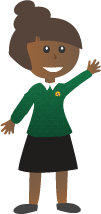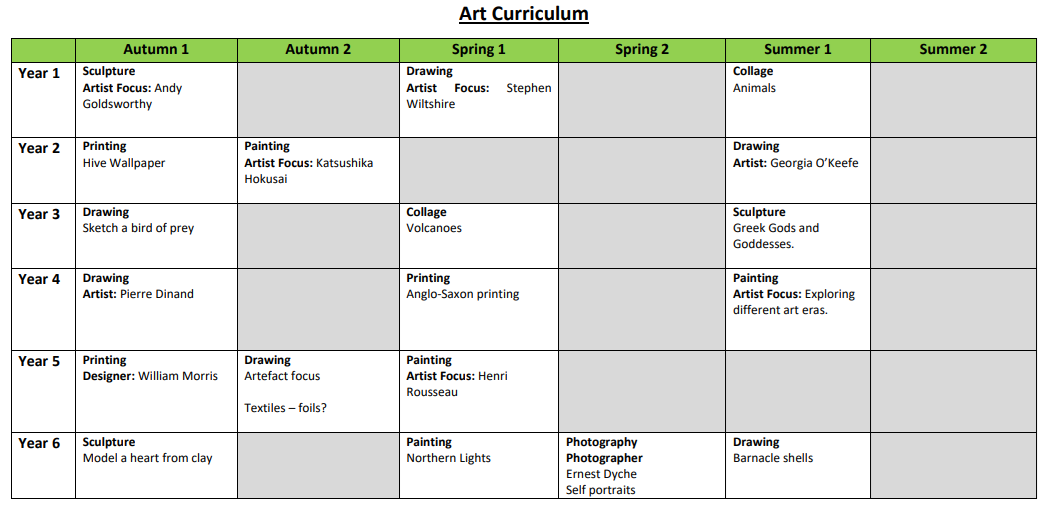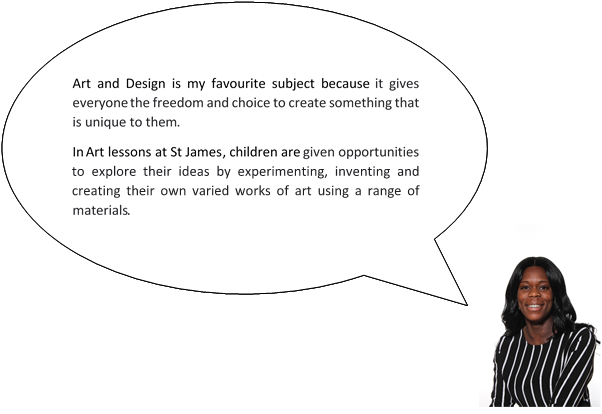
Art

“I found I could say things with colour and shapes that I couldn’t say in any other way - things I had no words for.”
Georgia O’Keefe
Intent
At St. James our high-quality Art and Design curriculum inspires, engages and challenges children, enabling pupils to communicate what they see, feel and think through the use of colour, texture, form and pattern. Through the learning within Art and Design children have the opportunity to be creative and use their imagination. It provides visual, tactile and sensory experiences and a special way of understanding and responding to the world.
At St James, children will learn about a range of artists, designers and crafts people, art movements and styles across time and cultures, exploring ideas and meaning through the pieces of art which are studied. The Art and Design curriculum seeks to build knowledge upon knowledge and skills upon skills sequencing progression through the school. As a result, competence and confidence will be developed by the children.
Through our intent for this subject, we hope to enable children to become more involved in shaping their environment by taking part in a range of art and design activities and use a range of different creative techniques. Additionally, as they learn about the history, roles and functions of art, they can explore the impact that it has on contemporary life and that of different times and cultures.
Implementation
Our Art curriculum is structured to give pupils different opportunities and experiences, all underpinned by creative use of sketchbooks. Sketchbooks are a valuable tool in our curriculum, allowing children to document their design process, experiment with different materials and techniques, and reflect on their progress and learning. Using sketchbooks, children can refine their designs, troubleshoot problems and make changes to create a final product that meets their goals and objectives.
The Art Curriculum at St. James has five distinct steps which helps children to develop and build on skills:
Prior Knowledge:
To start the Art sessions, children revisit previously taught skills and techniques that will help them create their finished pieces. Children will focus primarily on the Elements of Art which are fundamental components of all pieces of Art.
Generating Ideas:
Learners develop their knowledge of Art and Design practices through the study of a range of artists and designers. In this stage, looking at the work from Artists, children explore the different elements of Art observed as well as identifying key techniques used.
Skills Development:
This stage is about selecting ideas, visual elements, compositions and techniques from Artists and Designers to use them in new ways. It is an important part of the creative process to try out new things and to make creative decisions and children are encouraged to show creativity.
Making and Producing Artwork:
At this stage, children have been equipped with skills needed to develop their final pieces. Using key techniques, learners will begin to develop their own art pieces using a range of different tools and materials.
Evaluation:
This stage encourages children to reflect on their learning on the unit of work they have completed. They will think about how their artwork is similar or different to that of their peers or other known artists and discuss their increasing knowledge of artists, artworks and art movements.


